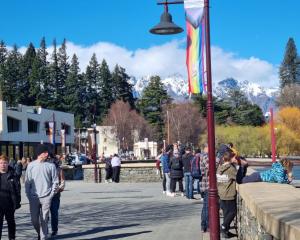New Zealand Oil and Gas has finished its seismic testing off the coast between Dunedin and Oamaru. Business editor Dene Mackenzie asked chief executive Andrew Knight about the next steps in the search for hydrocarbons.
New Zealand Oil and Gas chief executive Andrew Knight was positive and enthusiastic when he called at the Otago Daily Times this week to talk about the company's latest seismic testing.
The company has completed an incident-free 3D seismic survey covering about 700sq m of the Clipper permit off the coast between Dunedin and Oamaru.
The company was operating under the new Seismic Code of Conduct in relation to the noise levels permitted for the testing. The code was introduced to mitigate the effects any noise might have on sea mammals during the testing.
There were four marine observers on the testing vessel - two visual and two acoustic.
''We came well under the limits of the code. We are at the vanguard of this testing, being the first seismic survey to be carried out under the new code and proving our technology to be world-leading.''
Each day the majority of sightings were of fur seals, along with some dolphins and whales.
At $300,000 a day, any delays would have been expensive but the testing vessel ''sailed clear'', Mr Knight said.
The seismic data had been sent overseas for processing. That would take about six months to complete, followed by a year or so of analysis before a decision was made whether to drill for gas.
NZOG permit manager Nick Cozens said the raw data had to be turned into something the company could use to make the decisions on drilling.
The company and its joint-venture partners were sitting on three areas with comparable attributes that tied back to the Galleon permit of 1985. The formation had ''sub-commercial'' success in 1985 and was where Texas oil giant Anadarko was drilling now.
''We know hydrocarbons are in the area but we need to find whether there is enough to make it commercial. We won't know until we get the detail of the data.''
It was easier to prove against drilling, with a nine in 10 chance there was not enough gas to make it commercially viable, Mr Cozens said.
At a cost of tens of millions of dollars to drill, a lot of analysis would be carried out to get to that point.
Asked why there was such a sudden rush to the Canterbury and Great South Basins, Mr Knight said the Government had done a good job promoting the industry. The basins were regarded as ''frontier'', as they had not been explored enough to collect sufficient data.
Anadarko was drilling in Mozambique and, in 10 years, that country would become the third-largest producer of oil and gas and it was all for export.
Mr Knight warned New Zealand was not about to turn into California of the 1800s. There would be no gold rush. But the area was proving attractive enough for overseas companies to come to try their luck.
Woodside, NZOG's joint-venture partner, had not worked in New Zealand before but now it was here, he said.
Whether oil and gas companies would establish bases in Otago, or other areas, has been a keenly debated topic recently.
Mr Knight said when the Kupe field was developed, the project employed between 2500 and 3000 plumbers, electricians, builders and other tradespeople. Numbers reduced once the project was operating but there was still a need for ongoing maintenance by the various trades.
''It's a tremendous boost to a local economy.''
Mr Cozens said highly skilled technical workers were required to safeguard the company's intellectual property during the drilling. Those jobs were ''back at base''. Once the IP had been protected, it could be used in other areas, such as Indonesia, which had similar characteristics to New Zealand.












